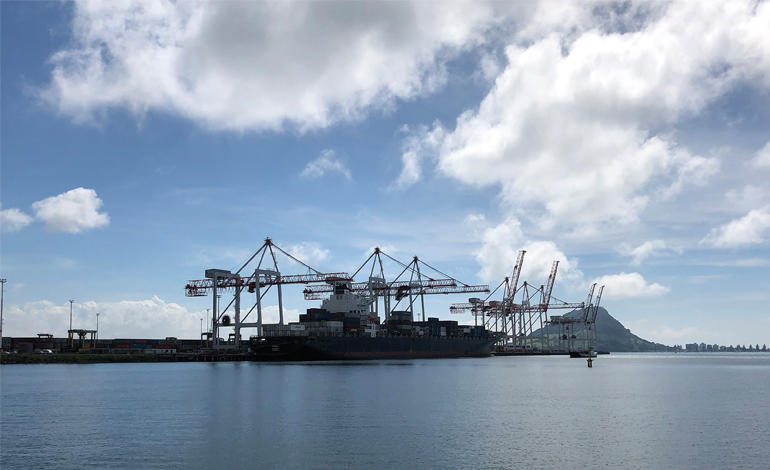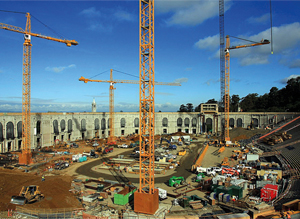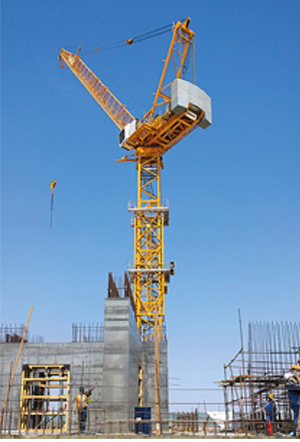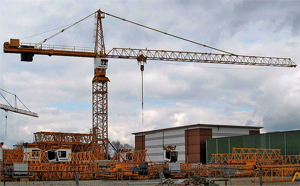Liebherr New Zealand has now acquired Morrow NZ, former distributor of Liebherr tower and marine cranes here, and a new chapter in an interesting crane story begins. Richard Campbell explains.
A look around any cityscape will reveal tower cranes, they are everywhere and pop up seemingly overnight in some places.
A closer look will reveal that the majority of them are manufactured by the German company Liebherr, a company with a long and varied history.
The literal translation of the German name Liebherr is “dear sir”!
Hans Liebherr founded his business in 1949 and his very first piece of equipment was a mobile tower crane he designed and built himself, the TK10 (turmdrehkran – tower crane).
It ran on a short length of track, and although of simple design, it was very robust and extremely useful. Liebherr Maschinenfabrik was in business!
Germany was in a pitiful state following WWII and the need for construction equipment, especially cranes, was very high as buildings had to be demolished and more replacements built.
Based in Kirchdorf, Germany, Liebherr began building other models in the TK range with varying lift capacities to cater for customers’ requirements.
As some components were hard to source and a great deal of machine tooling had been destroyed during the war, Liebherr began building his own.
This kept more of the crane production “in-house” and allowed for stricter quality control.
This policy of internal manufacturing was further boosted in 1984 when Liebherr began constructing its own diesel engines.
Hans Liebherr was somewhat of a visionary, and could see the need for other construction equipment to help rebuild a shattered Europe.
His next commercially available machine was introduced in 1954 – a mobile hydraulic excavator, the very first in Europe.
This machine, the model L300, was not particularly attractive but did a good job, cheaply, and was readily accepted.
Meanwhile, the tower crane business was booming and the decision was made to set up a manufacturing facility to build cranes outside of Germany to cater for the demand.
A site was chosen in Killarney, Ireland.
Tower cranes and large container cranes are still built at this facility today.
A new plant in Nenzing, Austria, was also constructed to manufacture crawler cranes.
As the German plant in Kirchdorf was by now a little overcrowded, and the demand for products increased, Liebherr looked about for a new European site which was to be dedicated to the manufacture of hydraulic excavators.
Colmar, an old historic town in France, close to the Swiss border, was chosen and this site has seen continual expansion to the present day.
All of Liebherr’s medium to very large hydraulic excavators are manufactured at Colmar and exported worldwide.
During the 1960s, Liebherr diversified its operations even further entering the home refrigeration market and the aerospace industry, two very unlikely bedfellows for sure but both of which have been extremely successful.
Liebherr fridges & freezers are considered the “Rolls-Royce” of home appliances while its aerospace division manufactures undercarriages and air conditioning units for Airbus Industries.
In 1977 the company introduced the first of it’s LTM on/off road mobile cranes, a product line which is respected as the very best of its type.
Liebherr manufactures some truly spectacular mobile cranes!
Around this time Liebherr also introduced its own designed wheel loaders, track loaders and bulldozers.
These were built at all new plants in Austria – Bischoffshofen for the wheel loaders and Telfs for the tracked machines.
Back to the tower cranes
One of Hans Liebherr’s most important inventions was the self-climbing tower crane in which the unit inserts modular sections within itself to increase its height without external assistance, thus allowing it to climb as the building’s height necessitates.
While some other companies have since copied this idea, Liebherr was definitely the originator of this highly successful concept.
Another was the fast erecting tower crane, a smaller, highly mobile tower crane that can be towed behind a truck and set up and dismantled at very short notice, ideal for housing sites and building contractors on a budget.
Hans Liebherr passed away in October 1993 and control of the company passed on to his two children, Willi and Isolde who still run the business today along with their own children who each have important roles in the management structure of the company.
Morrow New Zealand
Morrow’s was originally an American company, founded in Oregon in 1968 and over the years has concentrated on the tower crane and construction hoist market.
An Australian division, Morrow Australia was established in October 1981 and the following year, a New Zealand division was established in January 1982 and has been the NZ dealer for Liebherr tower cranes since that time with Bill Houlker as general manager.
There was little tower crane activity in New Zealand back in the early 1980s, but people suspected a boom was coming and it did in 1984 – with a vengeance.
Things weren’t quite so easy in those days as the government had decreed that there had to be a substantial amount of local manufacture incorporated in the finished product to avoid heavy tax duties.
This meant that the towers, jibs and tower heads were all fabricated in New Zealand from kitsets made up in Germany.
This unfortunate state of affairs persisted until 1988 when the government relaxed the laws regarding local content.
The global financial crash of 1987 put paid to a great deal of machinery sales and affected the building industry in New Zealand particularly badly – Morrow’s not selling a tower crane for over five years!
To further reinforce its position within the NZ crane market, Morrow NZ approached Liebherr with a view to also obtaining the distributorship for its mobile harbour cranes and container gantry cranes which was duly agreed to.
Morrow’s installed these cranes at the ports of Tauranga, Taranaki, Wellington, Nelson, Lyttleton, Timaru and Bluff as well as off-shore sales to ports in Noumea and Tahiti.
Not bad going at all for a small New Zealand company.
Liebherr in New Zealand
Liebherr New Zealand was incorporated in 1993 and is a branch of Liebherr-Australia Pty Ltd.
Initial market penetration was into the general earthmoving sector but quickly evolved to include surface mining equipment which was used at sites in both the North & South Island.
With the acquisition of Morrow’s NZ, this year, Liebherr New Zealand has now become a full line distributor for all of Liebherr’s Crane, Earthmoving and Mining product ranges throughout our country.
The Liebherr crane range is truly mind boggling and vast, covering self-propelled mobile cranes, rough terrain cranes, crawler cranes, hammerhead tower cranes, luffing tower cranes, small fast erecting cranes, maritime cranes and container cranes as well as other specialised materials-handling equipment.
Within the mobile crane range alone there are models up to a staggering 1200 tons lifting capacity!
Crane specialists Bill Houlker and Tom Curran are available to tailor any type of Liebherr crane to fit your requirements.
Liebherr for the model collector
Be it earthmoving, mining or cranes, Liebherr enthusiasts are well catered for.
The German diecast companies Conrad and NZG both manufacture a wide range of Liebherr models to 1:50 scale as does the Dutch company WSI.
Liebherr saw the benefit of offering scale models of its equipment very early on and has been well represented in model form since the late 1960s.
Some of the older models now change hands for substantial amounts of money.
Liebherr New Zealand has a range of current production models for sale through its promotional shop.





